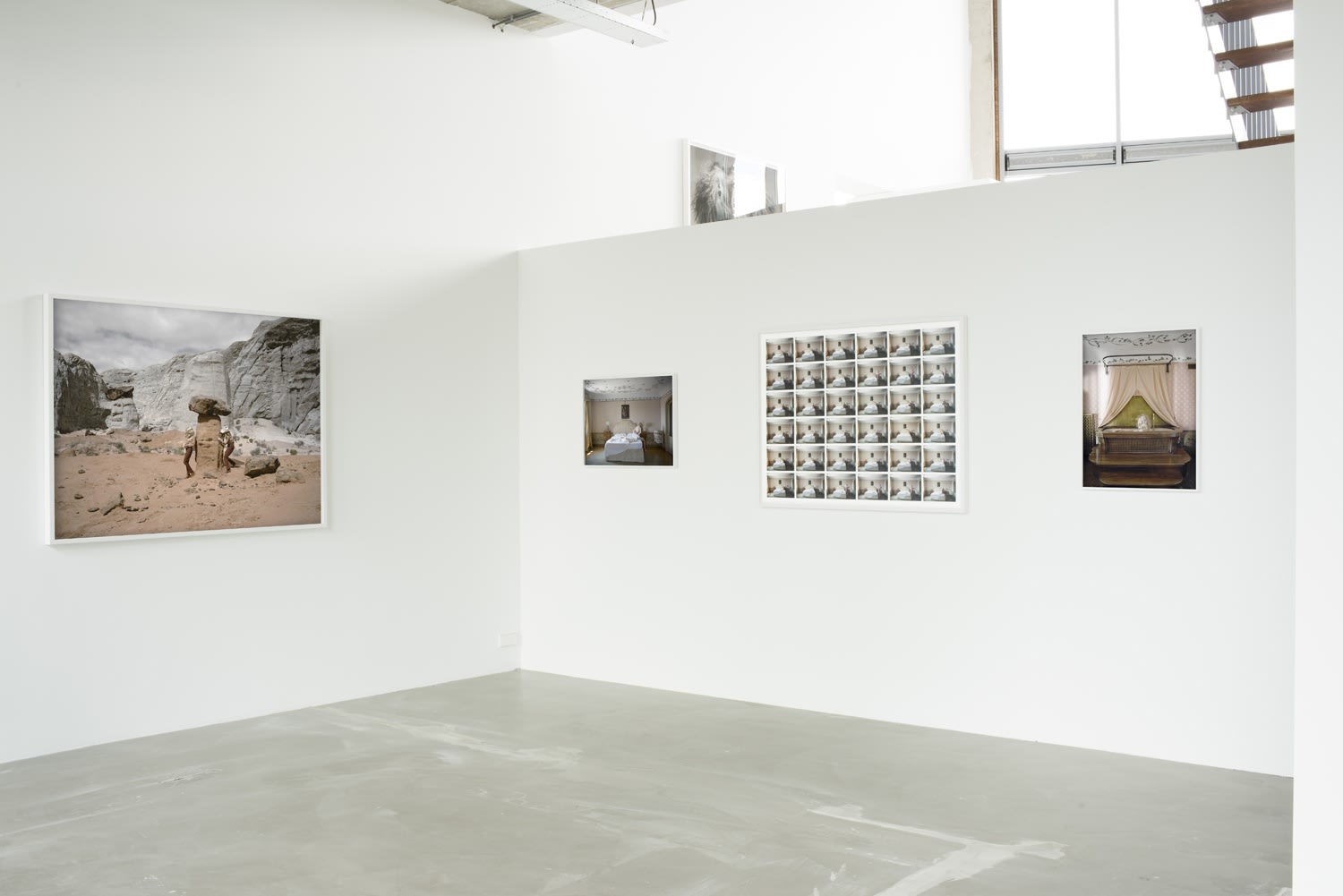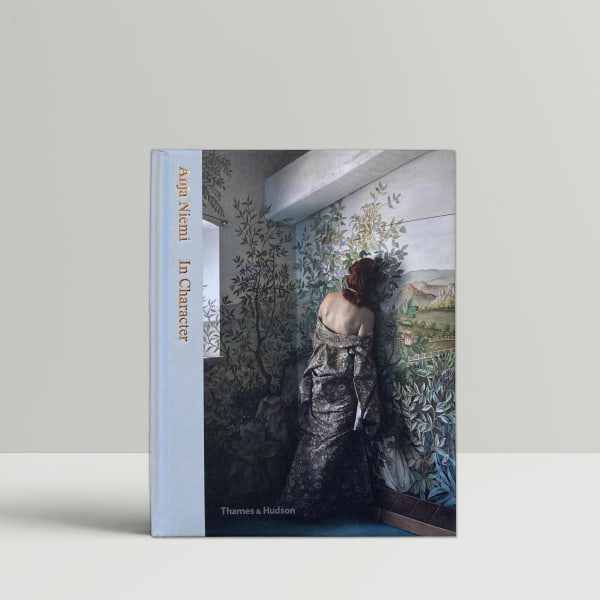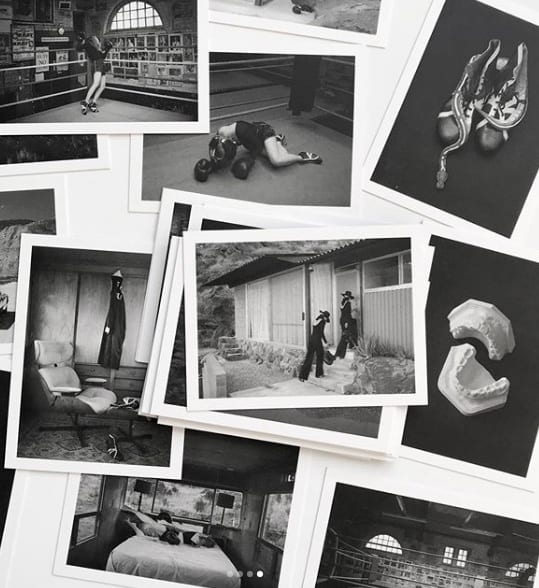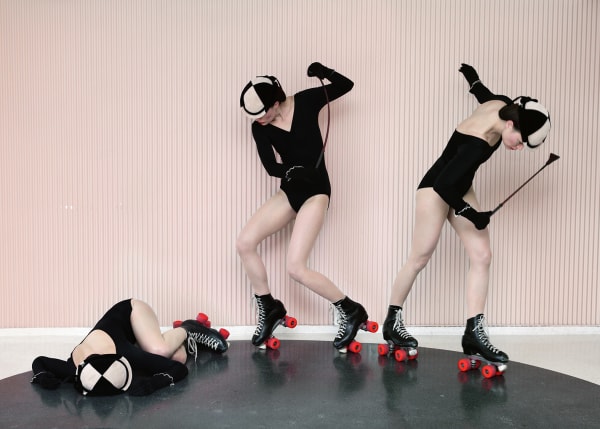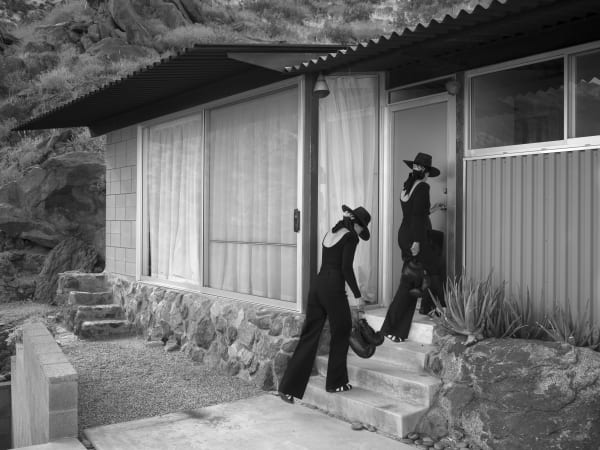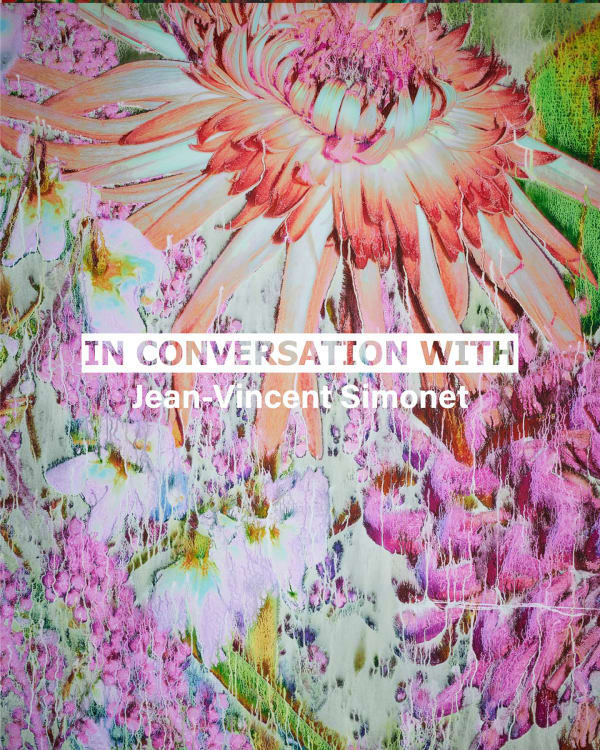-
Words by George King
A distinct cinematic quality permeates the work of Anja Niemi (b. 1976, NO); working alone, her projects feature a role call of evocative characters, imagined, styled and performed by the artist. But in Niemi’s most recent work, A Naturalist Guide to Magic, the story she spins is increasingly autobiographical, whilst her creative approach invites intuition over meticulous planning. Reflecting on her career thus far, Niemi describes the real-life events that have inspired her change in outlook.
-
The Duel, 2018
Click on image for more information -
-

-
-
"The case once belonged to a beauty counsellor named Darlene". - Anja Niemi
George King (GK): I know it's a big question, but maybe we could start by plotting some of the projects you've turned out thus far - what brought you to this point?
Anja Niemi (AN): I've been photographing and using myself in my work for over 20 years now, but the Darlene & Me project feels like the beginning of where I am now. This was when I started to work with images as series that formed a collective story. I made Darlene & Me in 2014, and it all started with the contents of a suitcase from 1959. The case once belonged to a beauty counsellor named Darlene - it contained makeup samples, brochures and the receipts from her few sales. Most of the case's contents appeared to be untouched, but in August 1960 Darlene sold two items: both to herself. I started to picture her alone playing it out, being both beauty counsellor and customer. This led me to a character with a multilayered relationship to herself. The series consists of 9 photographs, all revealing a part of her story.
I then moved on to The Woman Who Never Existed, which was based on an actress from the 1920s. It was a reaction to the lives we're living now: where we're constantly sharing things and becoming addicted to validation. The character led a kind of actress's life, but behind it there was nothing.
-
-
The Blow
14 December, 2019 - 18 January, 2020 -
GK: So there’s some clear patterns in terms of building quite particular characters in your projects. I’m also thinking of the boxer you portrayed in The Blow – what inspired that series?
AN: Yes, The Blow came right before the pandemic. When I made it, I was going through something really hard; I was searching for some resilience, so it was about imagining someone with the strength to keep getting up. When the pandemic happened, it made even more sense, because we were all in that state. I never imagined her as a winner necessarily, but she just kept working at it. After that, my series The Rider also featured a character who wasn’t strictly ‘succeeding’, but instead on a journey – which was closely related to my own at that time. It’s as if she’s trying to achieve something, not really getting there, but learning to find beauty and enjoyment in the process.
GK: It’s interesting that you talk primarily about characters in the way we might expect from a writer or a director. How did this creative approach emerge?
AN: I was born with a big imagination, but I lacked the confidence in my vocabulary to speak my mind or articulate my ideas. I was horrible at school, and I never really found my thing, but from the minute I picked up a camera – I shot a roll of film when I was 18 – that’s pretty much all I’ve done since. Photography was a way to tell stories without words, which was magic for me!
I also have this other thing where I’m not that comfortable with people, and I never really have been. I never imagined working in a big crew, or making something for someone else. When you start out, you’re in your bedroom trying these small ideas without people watching what you’re doing – you’re in your own small bubble. So that’s really how it started: I would use myself because I wanted to be alone. From there it expanded, the ideas got bigger, and somehow you end up having a small audience. When you realise someone’s watching, you have to pay attention to what you’re saying.
GK: So it’s always been a very personal process somehow?
AN: Yes! Even if it wasn’t about me wanting to share my life, it’s about wanting to tell a story that has to come from me. Across these projects, I’ve always wondered how not be in the pictures! It’s impractical, and I don’t necessarily want to be in front of the camera, but I never found a way for that to make sense. Who else would it be, and how would I tell them how I feel? It wouldn’t work. So what runs through everything is the journey, and as soon as I dared to step out into the world, everything got bigger. That was a really big thing for me – to dare to go out and be seen making.
-
-
She Could Have Been a Cowboy
8 September - 27 October, 2018 -
"Especially when I see my ideas getting bigger – I’m like, ‘how can I pull this off by myself?’" - Anja Niemi
Installation view of She Could have been a cowboy at The ravestijn gallery amsterdam
INSTALLATION VIEW OF SHE COULD HAVE BEEN A COWBOY AT THE RAVESTIJN GALLERY AMSTERDAM
GK: I like that idea of trajectory – of you starting off in the hotel room and slowly getting braver: into the big sweeping landscapes we see in She Could Have Been a Cowboy, for instance?
AN: Exactly! She Could Have Been a Cowboy was a really big change for me. It was the first time I was really stepping out into nature on a big solo journey. That story was about a character who was living a life she didn’t want – she dreamt of being someone else. I wanted to take that on, and I really felt her emotions throughout that whole journey. I was in the US for about a month, driving through the country with my costumes and my camera, daring to step out and be her. In a lot of the pictures she’s standing there with pride, or on a horse – so I just had to own it! That led me to want more of that, to make the experience and process bigger.
GK: You’ve explained that you’re essentially a one-woman-band, but what’s like to play stylist, location scout, cinematographer, director and actress simultaneously?
AN: I keep asking why I made this so difficult! Especially when I see my ideas getting bigger – I’m like, ‘how can I pull this off by myself?’ But it comes back to that personal aspect. How could I let someone else choose the clothes? The costumes are more than clothes, they’re character triggers. One of my favourite pieces is a pair of vintage black and white rodeo chaps. They used to belong to a woman named Mary, who’s now 87; when I put them on, I imagine her wearing them as a young rodeo rider. It really makes the character come to life! To have someone else find the clothes would feel wrong – so I have to do that. Or maybe I just want to! And we’ve spoken about the acting side of things, of being the character. Physically, the hardest thing is when you’re on location and working against weather or time or animals, and simply the act of carrying everything: costumes, cameras, walking through woods, climbing up mountains. It’s not very practical, but it has to be done. There is a reward to it all though, seeing your idea through in every detail all the way to the end.
 Installation view of She Could Have Been a Cowboy at Fotografiska Talinn
Installation view of She Could Have Been a Cowboy at Fotografiska Talinn -
GK: Given all the cinematic strands in your work, is there a profound interest in film underneath everything? If so, who has inspired you over the years?AN: Yeah definitely: David Lynch, Hitchcock, Ingmar Bergman. When I was a teenager, Twin Peaks was on, and we all just lived by it! I was from a small town in Norway, and this show was absolutely packed with surrealism and dark characters, every single one is so rich and interesting, and I think – without realising it at the time – it really opened my mind creatively.
I’ve never been a movie director, so I don’t know, but I feel like there’s similarities in my process – my work tends to start with an idea, then a character, I think about who she is, what’s she doing, what she wants to say. Then I draw a storyboard around that, but the images are never meant to be read from beginning to the end. You can read them in any order, and the pieces are scattered with an open ending.
GK: There’s characters in your projects that feel vaguely familiar: are there certain archetypes you like to reimagine or perform?AN: I think the core of what I normally want to come across is just human emotions: things that we all feel or go through. In this process of removing myself – because my face is often hidden – I want to talk about all of us, so that anyone can relate to these feelings. They’re not my emotions, and I don’t want to tell you how I feel. By putting these pieces in a character that’s almost non-human, it can become any human – if that makes sense?GK: Absolutely! It invites us to project our own fantasies.AN: Much more easily than if you’re looking right into someone’s face! And even if the characters are women with big wigs, their emotions are not gender specific. The cowboy character, for instance, stands for so many things we can identify – strength, self-reliance and the freedom we imagine comes with being a cowboy.GK: There’s quite some Americana in characters like that, too: do you see these works being rooted in a particular geography?
AN: I think the location is almost like the character – it could be anywhere, anyone, anytime. Even the costumes are mixed up with 20s, 40s and 70s stuff. It’s mainly about how it makes you feel, but indeed I do keep getting drawn to America because of that cinematic, iconic aspect. It’s like the cowboy: we know that character, and it’s as if it comes from a place of fiction. People often ask me why I don’t photograph in Norway, but it’s my backyard. I needed to go elsewhere to play out the stories – places that felt fictional to me because I don’t live there. I think I might have had a change of heart here actually having recently discovered that there is magic here too, I just wasn't looking at it the right way.
GK: What is it that makes photography your medium of choice?
AN: I’ve said this before, but I often imagine my work as a very slow silent movie. A film has a certain duration, a beginning and an end. It has movement to create emotion and sound to steer how you feel. Although I often wonder what it would be like to make my images move, I’ve felt really content so far with what I can say through photography. I like the room It leaves for personal projection, and the story never really has to end. Recently I’ve been thinking about how to slow it down even more, creating more with my hands – something more organic. But I think my work will always have the photograph as it's back bone.
-
A Naturalist Guide to Magic 2024
First view -
GK: And is that organic quality something we can expect in your new project, A Naturalist Guide to Magic? I’d love to know more about the project!
AN: I’ve been working on this series for a while, without realising it at first. It really just evolved from the ongoing process of learning how to talk to a rather complex American Quarter horse. I’ve been trying to understand him – and in the process, I’ve ended up trying to heal us both. At the start of our journey, he was very clear about two things: that he wasn’t fine and neither was I. It was really overwhelming! I was flooding myself with information, opening up every door I could think of in search of answers. About a year went by, and I realised I basically hadn’t worked throughout that time. The horse had taken over my entire world. Then I started to intertwine the two – resuming the journey, but beginning to photograph, keeping my focus on how we communicate and all the new things I was discovering.
GK: It sounds like a huge challenge in every sense!
AN: It was, but he was opening my mind to a world I was previously unaware of. I was becoming better at listening to my intuition, and I eventually felt as if we were having two-way conversations. I could hear him, which made we wonder, if I’m having a conversation with a horse, who else could I talk to? Can we talk to trees, can we talk to plants, rocks even? When you step into nature and look at it from that perspective, it really changes your vision of the world. Most of them might not talk back but I don't think it matters. Either way I think we can benefit from treating the world as if it is alive. He also made me question everything I thought I knew about being with horses. If you’re having a conversation with someone you view as your friend and your equal, the dominant relationship no longer feels right. I realised I had to find another way. Could he have more choices, decide where we go, for instance? Can he say that he doesn’t want to be ridden today? Is it ok for him to say no? Lots of questions came from this process of trying to figure out what needed to be fixed, but then it became even bigger – about how we can be one, or equal. He certainly made me realise that he wasn’t the only one who needed to listen. -
"To communicate properly, you have to radiate calmness." - Anja Niemi
GK: It’s almost as if you could be talking about the power dynamic between photographer and subject!
AN: I hadn’t thought about that, but it’s interesting. And to come back to your question about whether the project has a more natural feel – I’ve learnt so many things from him, and one of them is that I need to slow down. I want to notice things, to be more aware. I started meditating, practicing conscious breathing, drawing, reading poems, anything that would slow down my thoughts. I wanted to be able to clear my mind so that he could feel my energy and be comforted, feel safe. That was the hardest one for me, to stand next to him with enough strength and calmness to put him at ease. I started reading him Maya Angelou’s poem Still I Rise, planting my feet steady on the ground as I read with confidence and rhythm. It would shift my focus, and every time he seemed to calm and soften his expression. We’ve since progressed to a wide selection of poems but we always come back to this one: it’s something about the combination of strength and rhythm I think. But I‘ve really enjoyed the effect that poetry’s had on us both, and I’ve even started playing with jotting down words that arrive spontaneously. If my earlier work felt like short films, maybe these new ones feel more like small intuitive poems?
-
-
GK: It’s such a shift from everything being so meticulously planned and orchestrated! There’s a bit more chance, maybe?
AN: Yes! And instead of imagining a gallery show with this project, I’m trying to imagine a book. In the end, I don’t know what form it will take, but by imagining a book, I’m allowing every image to be enough. I don’t want to have all this pressure on single images – they don’t all have to be giant 2-metre prints in an exhibition – and there’s so many tiny moments that I’ve loved along the way that I want to convey. If this journey’s about anything, it’s about those tiny things. I’m going to sound a little philosophical, but my big moments always used to be these huge events – like museum shows – where I had all this pride in what I was doing. But now I’m finding magic in all sorts of places, in subtle moments. It might be when my horse chooses to stand beside me, or when a deer crosses my path and looks at me calmly, without feeling the need to flee right away. The emotion is just as big! Maybe there’ll be lots of images, not all huge – but actually they are.
GK: In terms of the images themselves – obviously they resonate with the journey you’ve been on – but who is the character you’re playing?
AN: It’s inspired by this particular journey, so there’s lots of that in there, but she is fictional. She’s a naturalist – letting herself be guided by her discoveries. She wants to see where it will lead, because the world looks completely different once you follow it.
-
-
Special thank you to George and all the inspiring and generous people I have met and spoken to during the production of A Naturalist Guide to Magic, this ended up being far from a solo journey as my encounters formed things along the way. And to my horse Mercury, thank you for opening my mind to a new world and for your daily teachings of profound things.
Anja Niemi
To discover more, visit our website at www.theravestijngallery.com. Feel free to reach out to us at info@theravestijngallery.com if you would like to receive more information or acquire one of Anja Niemi's pieces.
The Ravestijn Gallery team &

-
-
Exhibitions
-

Galerie XII | 'The Blow' & 'The Rider Vol. 1'
Anja Niemi 10 September - 25 November 2022Niemi always works alone. By placing herself within her own meticulous tableaux, she constructs fictional stories where she is both the author and the character. In her work, Niemi appeals... -

'The Rider Vol. 1'
Anja Niemi 30 October 2021 - 8 January 2022The Rider Vol. 1 is an ideological progression from Anja Niemi's previous series The Blow (2019), in which a female boxer has the lead role. The Blow is an allegory... -

'The Blow'
Anja Niemi 14 December 2019 - 18 January 2020At first glance, Anja Niemi’s new work shows an unaccompanied woman, dressed in black and with a face that is always turned, driving to a solitary house in the desert.... -

'She could have been a Cowboy'
Anja Niemi 8 September - 27 October 2018Suppose I were to tell you about this cowboy who’s not really a cowboy, not in the regular sense of the term, not in the sense that she drives cattle,... -

'The Woman Who Never Existed'
Anja Niemi 4 - 27 May 2017The Woman Who Never Existed by Anja Niemi was inspired by the words of the pioneering Italian actress Eleonora Duse. Eleonora worked the international theatre stage alongside Sara Bernhardt in... -

'Darlene & Me'
Anja Niemi 15 January - 10 May 2015In her series Darlene & Me Norwegian photographer Anja Niemi explores the relationship we have with ourselves. The idea behind the series was born when Niemi happened to find a... -

'Starlets'
Anja Niemi 4 - 29 June 2013In Starlets, Niemi continues to combine the self-portrait with the idea of the staged narrative. The images are like film stills with herself playing all the characters - a 'ne-man... -

'Do not disturb'
Anja Niemi 27 March - 21 April 2012The images continue the artist's relationship with interiors, this time hotel rooms. “I merge myself into the interior of rooms” Niemi has said in regard to some of her earlier...
-
-
-
Publications
-
-
Press
-

The Blow – The Rider: Anja Niemi | Galerie XII
November 1, 2022The Blow — The Rider, an exhibition of two photographic series produced by Norwegian artist Anja Niemi in 2019 and 2021, respectively, explores the concept of domination both formally and... -

Art of Solitude
October 8, 2021Norwegian contemporary artist and photographer Anja Niemi on the empowering effect of embodying a different version of ourselves. Throughout her spellbinding work, Anja Niemi celebrates the ‘other,’ whether that’s a... -

In Conversation With Anja Niemi
May 21, 2021The art of solitude. The Norwegian contemporary artist and photographer on the empowering effect of embodying a different version of ourselves. Throughout her spellbinding work, Anja Niemi celebrates the ‘other,’... -

Incredible Women: Hasselblad's Heroins Of 2021
May 10, 2021As part of its annual celebration of seven accomplished female photographers, camera manufacturer Hasselblad recently unveiled its Hasselblad Heroines of 2021. Though the women have a wide range of specialties,... -

FD Persoonlijk: The Ravestijn Gallery in Amsterdam
December 28, 2019FD Persoonlijk bezoekt galerie in Amsterdam: In The Ravestijn Gallery maakt Noorse Anja Niemi fictieve fotoverhalen, waarin ze zelf de hoofdrol speelt. Een terugkerend thema in haar werk is Niemi’s...
-
-
-
OTHER EPISODES
-

In Conversation With: Mathieu Asselin
b. 1973, France -

In Conversation With: Jean-Vincent Simonet
b. 1991, France -

In Conversation With: Nico Krijno
b. 1981, South Africa -

In Conversation With: Eva Stenram
b. 1976, Sweden -

In Conversation With: Katie Burnett
b. 1985, USAA stylist by trade, Katie Burnett has always collaborated closely with photographers across assignments in fashion. But periods of pandemic lockdown, when she was unable to work on set, were... -

In Conversation With: Pacifico Silano
b. 1986, USAWorking as a lens-based artist, Pacifico Silano strives to appreciate gay identity through (gay pornographic) magazines from the 1960s, 70s and 80s. He interrogates the line between desire and masochism,... -

In Conversation With: Theis Wendt
b. 1981, DenmarkOften illusionary, occasionally subversive, and invariably crafted from a broad toolbox of materials and techniques, Theis Wendt’s works reflect his preoccupation with age-old questions of the human relationship to authenticity.... -

In Conversation With: Michel Lamoller
b. 1984, GermanyLast two weeks to see the acclaimed exhibition Anthropogenic Mass by Michel Lamoller, on show till Saturday June 18. An exhibition illustrating the mass of everything manmade which is now... -

In Conversation With: Mark Mahaney
b. 1979, USAAs a gallery we are always on the lookout for work that fascinates, resonates if you will, and sticks to you. Work we would like to acquire for our own...
-





